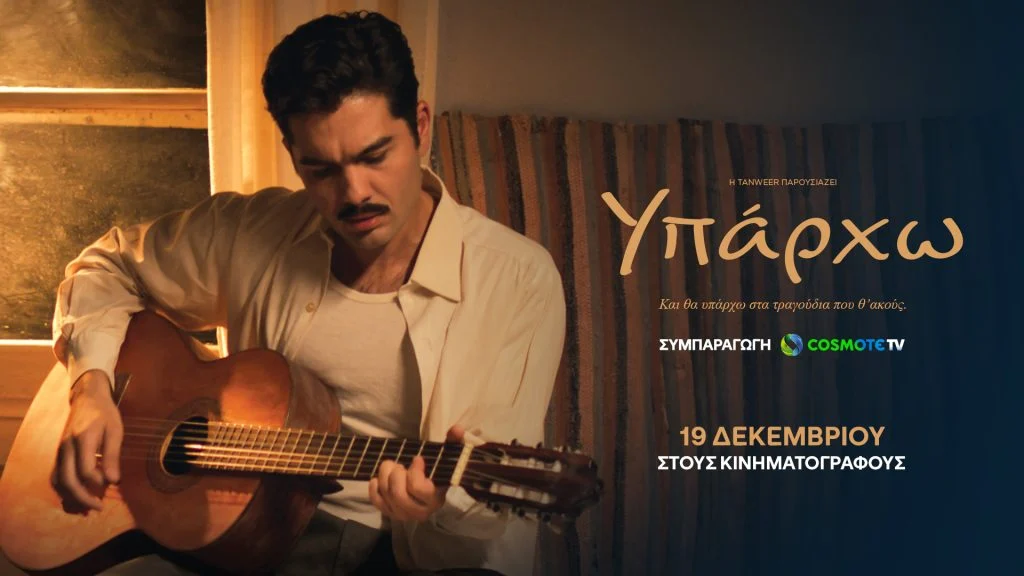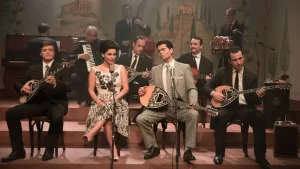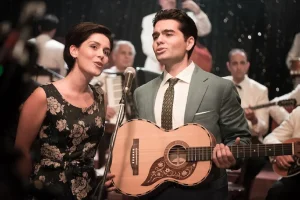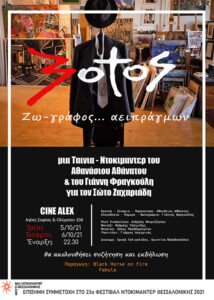YPARHO
Ιαν 06, 2025 Κινηματογράφος 0

MOVIE REVIEWS
STELIOS
A BRIEF ANALYSIS OF GREEK HISTORY
Yparho: written by Yannis Frangoulis
These thoughts are addressed to the people who have defined me,
to the child who gives me the strength to express myself.
To the women who put obstacles in our way
and to the women who take them away.
The touching story of a child of a refugee family from Pontus who managed to survive and grow thanks to his immense talent and against all social and personal difficulties. Music, loves, family, friends, fishing, creativity, night bouncers, fanatical fans, great conflicts, create the mosaic of his life. But the film strays from the confines of a portrait that would fatally press its narrative. It opens up the narrative and shows us the tragedy of the Greek soul in the modern history of Greece. These are the thoughts we will try to develop in the following.
Yparho: The narrative
The vehicle for developing this narrative is the Kazantzides phenomenon in Greek music. From the Occupation to the present day, little has changed in what tests the endurance of the Greek, what puts obstacles in the way of the development of the spirit and aspects of history in this country. George Tseberopoulos knows this very well. His stint in the so-called agonistic cinema, during the junta era, was a good way to develop the script through the politicization that this era demanded and the cinema that was now a weapon of resistance. His films then develop this cinematic structure that is related to that of Gavras in terms of fictional eloquence in the development of political concepts.
It has been 11 years since My Enemy (2013), which was his previous film. We don’t know how long he was preparing the script and direction for “I Exist” (2024), but he showed that he has not lost his narrative and directorial power as we knew it in “Megara” (1974), “Opposite” (1981) and “Goodbye…” (1991). On the contrary, it seems more powerful to fascinate the audience and to give a critic the opportunity to write “something more”, to extend the film work and to suggest some relations between the film and history.

Yparho: The two moments
The film starts from the childhood of Stelios Kazantzidis. It is the turbulent time of the Occupation and the Civil War in Greece. The death of his father will be the first element that will mark his mental world. All the more so when we see that the father was brutally murdered before his eyes. The second element was the trauma of a mule, something to do with the taboo of procreation, at that time. These two moments come up again and again in the film, they are implied throughout the script.
Stelios Kazantzidis shows his talent, as a singer, at work and in his neighborhood. He is recognized and quickly becomes a star in the glittering universe of singing. But that is not his purpose. His romantic character is a continuation of his father’s romanticism. He has charted a course that is non-negotiable. He wants to sing for the real Greeks, for the people, not to be the one to help enrich the song production industry and he wants to “nibble” something.
Yparho: The character
He likes beautiful women, but he is not willing to deviate from the path he has already set. Love affairs begin and end before he reaches the calm harbor of Vasso. His career follows a difficult path: the divas, the capital, the bouncers and mobsters of the night, the “wants” of those who say they believe in him and support him. If this reminds you of a consistent patriot or leftist, a romantic man who believes in his country and his nation, ultimately, in man, then you have not missed the mark at all.

I think George Tseberopoulos wanted to make a film about the Greek who wants to serve his country in the most proper way, in his opinion. Stelios Kazantzides is nothing but this excuse to talk about the tragedy of Greek history. If he wanted to do a portrait, he would have a lot of documentary elements and he would stay true to the life of Stelios Kazantzidis. But we have a fiction that does not belong in the realm of dramatic documentary. So we have to respect the director’s point of view, his will to talk about the Greek soul more.
Yparho: The identification
He picks up points of reality that will help him not to stray from the historical narrative as it has been written. Then, he wants and succeeds in making his own commentary which, as a personal viewpoint, will be a stimulus for the viewer to structure his own narrative, since many elements of the narrative belong to his own experience. The script finding of the interview by a young journalist is excellent, probably implied by George Lianis.
In this way there is identification, in a Brechtian way. These narrative trajectories create a movement, as Brexon would say, of emotions, and the emotion comes out on its own, without the director demanding it. The cinematic text opens up and meets the experiential narratives of the spectators who create their own narratives; at the end of the film they feel the “obligation” to applaud, as they would at a film at a festival where the director would be present. They essentially felt the presence of the director since the work spoke to them in a simple and understandable way.

Yparho: The actresses
The actors played very well. Everyone was his role. The protagonists, Christos Mastoras (Stelios Kazantzidis), Celia Renesis (Katie Gray) and Asimenia Voulioti (Marinella) played their roles faithfully. It would break the novelistic narrative if there was a playback in their voices. We didn’t go to the cinema to hear a musical concert or something like a revue, but to see a play about Stelios Kazantzidis. The editing provides that rhythm that the film needs to keep the viewer’s interest, without the songs as an aid. The costuming was accurate to the period. Something similar happened with the sets, in the smallest details.
The highlight of the film is “I exist”. We get to the core of the narrative. The emotion can’t come out on demand, i.e. the recording is done in pieces and then the editing. The song is recorded in the presence of the orchestra, the good old fashioned way. The crying of Kazantzides’ mother is a moment that has several components: the obstacles she has unwittingly placed in his way, the hysteria created by all the situations she has lived through, the tragedy her child is living through, his sincere and adamant struggle. This mother is the signifier of the Greek: she could have been any mother, any father, any son, any daughter… In other words, she is my Hecuba mourning her son, she is the soul of the Greek, the one who pulsates throughout the film. This scene prompts us to read the film from the beginning. Could it be, after all, that “I Exist” is “a proclamation”, as Christos Nikolopoulos says, by a man who “if he goes to the Constitution he will bring down the government”, as the film says?
STELIOS
Directed by Yorgos Tsemberopoulos
Screenplay: Katerina Bei
Photography: Giannis Drakoularakos
Editing: Giannis Tsitsopoulos
Music: Minos Matsas
Sound: Giannis Antypas , Aris Louziotis , Kostas Varympopiotis
Set designers: Antonis Daglidis
Costumes: Maria Kontodima
Producers: Dionyssis Samiotis
Actors: Christos Mastoras (Stelios Kazantzidis), Asimenia Voulioti (Marinella), Agoritsa Oikonomou (Gethsemane Kazantzidis), Klelia Renesi (Katie Gray), Dimitris Kapouranis (George), Anna Symeonidou (Vasso Kazantzidis), Yorgos Karamihos (Makis Matsas), Nikos Psarras (Takis Lampropoulos)
Production country: Greece
Year of production: 2024
Color: color
Genre: biography, tragedy, music
Release date: 19/12/2024
Distribution company: Tanweer
Duration: 132΄
For more information on technical characteristics and coefficients, see here..
Read the reviews we have published
Σχετικά άρθρα
-

-
 ΑΓΡΙΟΚΕΡΑΣΟ
ΑΓΡΙΟΚΕΡΑΣΟΣεπ 13, 2025 0
-
 ΜΑΓΚΝΤΑΛΕΝΑ ΧΑΟΥΖΕΝ...
ΜΑΓΚΝΤΑΛΕΝΑ ΧΑΟΥΖΕΝ...Σεπ 11, 2025 0
-
 ΧΙΛΙΕΣ ΛΕΥΓΕΣ ΚΑΤΩ...
ΧΙΛΙΕΣ ΛΕΥΓΕΣ ΚΑΤΩ...Σεπ 10, 2025 0
Στην ίδια κατηγορία
-
 ΓΙΑΝΝΗΣ ΚΑΡΠΟΥΖΗΣ
ΓΙΑΝΝΗΣ ΚΑΡΠΟΥΖΗΣΣεπ 14, 2025 0
-
 ΑΝΘΡΩΠΙΝΕΣ ΣΧΕΣΕΙΣ
ΑΝΘΡΩΠΙΝΕΣ ΣΧΕΣΕΙΣΣεπ 10, 2025 0
-
 ΤΕΛΕΤΗ ΕΝΑΡΞΗΣ
ΤΕΛΕΤΗ ΕΝΑΡΞΗΣΣεπ 09, 2025 0
-
 ΦΕΣΤΙΒΑΛ ΔΡΑΜΑΣ 2025
ΦΕΣΤΙΒΑΛ ΔΡΑΜΑΣ 2025Σεπ 09, 2025 0
Αναζήτηση
-
 WONDER WOMAN
WONDER WOMANΙούν 09, 2017 138
-
 ΠΑΙΔΙΚΗ ΣΚΗΝΗ
ΠΑΙΔΙΚΗ ΣΚΗΝΗΟκτ 12, 2014 2
-
 ΚΛΗΡΩΣΗ ΠΡΟΣΚΛΗΣΕΩΝ
ΚΛΗΡΩΣΗ ΠΡΟΣΚΛΗΣΕΩΝΜαρ 22, 2014 2
-
 ΔΥΟ ΜΕΡΕΣ, ΜΙΑ ΝΥΧΤΑ
ΔΥΟ ΜΕΡΕΣ, ΜΙΑ ΝΥΧΤΑΝοέ 13, 2014 2
-
 ΑΧΙΛΛΕΑΣ ΨΑΛΤΟΠΟΥΛΟΣ
ΑΧΙΛΛΕΑΣ ΨΑΛΤΟΠΟΥΛΟΣΝοέ 09, 2014 2
-
 ISTABUL FILM FESTIVAL
ISTABUL FILM FESTIVALΜαρ 08, 2014 2
-

-
 ΓΙΑΝΝΗΣ ΚΑΡΠΟΥΖΗΣ
ΓΙΑΝΝΗΣ ΚΑΡΠΟΥΖΗΣΣεπ 14, 2025 0
-
 ΑΓΡΙΟΚΕΡΑΣΟ
ΑΓΡΙΟΚΕΡΑΣΟΣεπ 13, 2025 0
-
 ΜΑΓΚΝΤΑΛΕΝΑ ΧΑΟΥΖΕΝ ΠΑΓΩΜΕΝΟΣ ΧΡΟΝΟΣ
ΜΑΓΚΝΤΑΛΕΝΑ ΧΑΟΥΖΕΝ ΠΑΓΩΜΕΝΟΣ ΧΡΟΝΟΣΣεπ 11, 2025 0
-
 ΑΝΘΡΩΠΙΝΕΣ ΣΧΕΣΕΙΣ
ΑΝΘΡΩΠΙΝΕΣ ΣΧΕΣΕΙΣΣεπ 10, 2025 0
-
 ΧΙΛΙΕΣ ΛΕΥΓΕΣ ΚΑΤΩ ΑΠΟ ΤΗΝ ΘΑΛΑΣΣΑ
ΧΙΛΙΕΣ ΛΕΥΓΕΣ ΚΑΤΩ ΑΠΟ ΤΗΝ ΘΑΛΑΣΣΑΣεπ 10, 2025 0

Δείτε το τρέιλερ της ταινίας μας, που συμμετέχει το Φεστιβάλ Ντοκιμαντέρ Θεσσαλονίκης.
SOTOS, EVERLASTING PAINTER (TRAILER)
Youtube
Επικοινωνήστε
ΓΙΑΝΝΗΣ ΦΡΑΓΚΟΥΛΗΣ
Email: info@filmandtheater.gr
Τηλ: (+30) 6974123481
Διεύθυνση: Ιωαννίνων 2, 56430, Σταυρούπολη Θεσσαλονίκη
![]()

